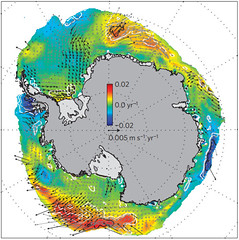

| Visitors Now: | |
| Total Visits: | |
| Total Stories: |

| Story Views | |
| Now: | |
| Last Hour: | |
| Last 24 Hours: | |
| Total: | |
Wind-driven trends in Antarctic sea-ice drift [Stoat]
 There’s a nice paper out by Holland and Kwok, attributing much of the somewhat-hard-to-understand change in Antarctic sea ice to changes in wind forcing. The growth in Antarctic sea ice, although much smaller than the decrease in the Arctic, is still a bit embarassing; it would be much tidier if it were decreasing. The abstract says:
There’s a nice paper out by Holland and Kwok, attributing much of the somewhat-hard-to-understand change in Antarctic sea ice to changes in wind forcing. The growth in Antarctic sea ice, although much smaller than the decrease in the Arctic, is still a bit embarassing; it would be much tidier if it were decreasing. The abstract says:
The sea-ice cover around Antarctica has experienced a slight expansion in area over the past decades [1,2]. This small overall increase is the sum of much larger opposing trends in different sectors that have been proposed to result from changes in atmospheric temperature or wind stress [3–5], precipitation [6,7], ocean temperature [8], and atmosphere or ocean feedbacks [9,10]. However, climate models have failed to reproduce the overall increase in sea ice [11]. Here we present a data set of satellitetracked sea ice motion for the period of 1992–2010 that reveals large and statistically significant trends in Antarctic ice drift, which, in most sectors, can be linked to local winds. We quantify dynamic and thermodynamic processes in the internal ice pack and show that wind driven changes in ice advection are the dominant driver of ice concentration trends around much of West Antarctica, whereas wind driven thermodynamic changes dominate elsewhere. The ice-drift trends also imply large changes in the surface stress that drives the Antarctic ocean gyres, and in the fluxes of heat and salt responsible for the production of Antarctic bottom and intermediate waters.
The pic I’ve nicked is Autumn (April–June) 1992–2010 ice motion and concentration trends and their relation to wind forcing. Wind-driven changes in ice motion are clearly linked to changes in ice concentration. Ice-motion trend vectors overlaid on ice-concentration trends.
So the theory is that sea ice on the edge of the pack (well, in those areas where the wind forcing is southerly) is there because its been advected north (it can’t form there thermodynamically, and is indeed melting there). And so if you increase the southerlies, you get more ice; because further south its cold enough to produce as much ice as you like, as long as you can export it. Of course all of this (assuming for the moment they are correct) just pushes the question one step further back, because they leave the changes in wind forcing unexplained. It may also help with the why-oh-why don’t GCMs produce the observed Antarctic response: because it isn’t the rather simpler to get right thermodynamics. Of course that’s probably part of why they don’t do so well in the northern hemisphere, too.
I used to share an office with Paul, BTW.
There’s also a Grauniad article. Lets take a look, and see how they do, shall we?
The mystery of the expansion of sea ice around Antarctica, at the same time as global warming is melting swaths of Arctic sea ice, has been solved using data from US military satellites.
A poor start. As I said, it hasn’t been solved, just pushed back one step to winds. And the “US military satellites” is a bit woo: they are just the satellite-derived sea-ice motion vectors, from DMSP I think.
Paul Holland at the British Antarctic Survey. “Our study of direct satellite observations shows the complexity of climate change. The Arctic is losing sea ice five times faster than the Antarctic is gaining it, so, on average, the Earth is losing sea ice very quickly. There is no inconsistency between our results and global warming.”
Accurate, and probably a good idea before the fools get overexcited. “In some areas, such as the Bellingshausen Sea, the sea ice is being lost as fast as in the Arctic,” is a useful reminder that the Antarctic trends are very regional (again, consistent with dynamics rather than thermodynamics). Overall, by newspaper-reporting-climate standards pretty good.
How about comparing the Graun to the Torygraph? Headline: Antarctic sea ice is increasing, byline The amount of ice in the Arctic may be at a record low but Antarctic sea ice is increasing, according to a new study. First two sentences rctic summer sea ice reached a minimum 3.41 million sq km this year, around 50 per cent lower than the 1979-200 average. However a study by the British Antarctic Survey (BAS) and NASA found sea ice in the Anatarctic has been increasing over the same period. Yes, they really are doing their best to mislead you. The next few sentences actually tell you something about the paper. Um, and that’s about it. A fail, I’d say.
Refs
* Nature Geoscience (2012) doi:10.1038/ngeo1627
* BAS press release
2012-11-12 18:25:55
Source: http://scienceblogs.com/stoat/2012/11/12/wind-driven-trends-in-antarctic-sea-ice-drift/
Source:


